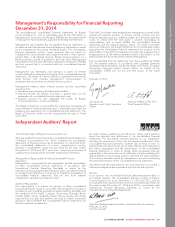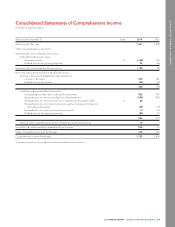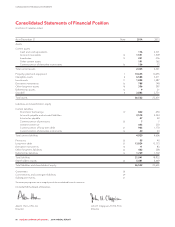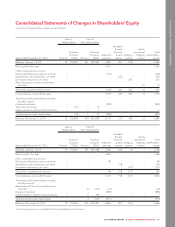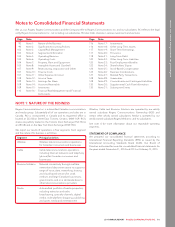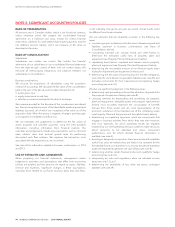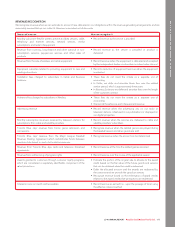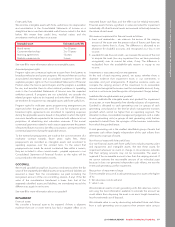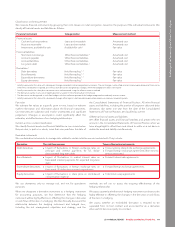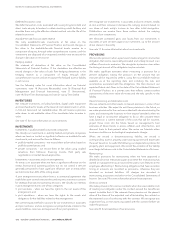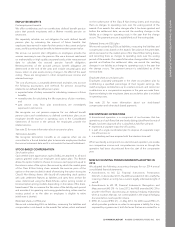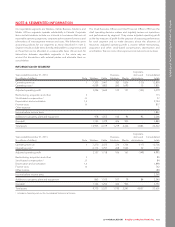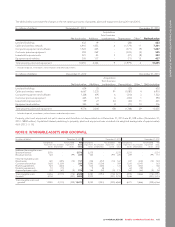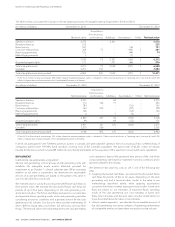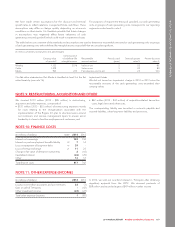Rogers 2014 Annual Report Download - page 101
Download and view the complete annual report
Please find page 101 of the 2014 Rogers annual report below. You can navigate through the pages in the report by either clicking on the pages listed below, or by using the keyword search tool below to find specific information within the annual report.
NOTES TO CONSOLIDATED FINANCIAL STATEMENTS
Finite useful lives
We amortize intangible assets with finite useful lives into depreciation
and amortization in the Consolidated Statements of Income on a
straight-line basis over their estimated useful lives as noted in the table
below. We review their useful lives, residual values and the
amortization methods at least once a year.
Intangible asset Estimated useful life
Brand names 7 to 20 years
Customer relationships 3 to 10 years
Roaming agreements 12 years
Marketing agreements 3 years
See note 8 for more information about our intangible assets.
Acquired program rights
Program rights are contractual rights we acquire from third parties to
broadcast television and sports programs. We record them at cost less
accumulated amortization and accumulated impairment losses. We
capitalize program rights on the Consolidated Statements of Financial
Position when the licence period begins and the program is available
for use, and amortize them to other external purchases in operating
costs in the Consolidated Statements of Income over the expected
exhibition period. If programs are not scheduled, we consider the
related program rights to be impaired and write them off. Otherwise,
we test them for impairment as intangible assets with finite useful lives.
Program rights for multi-year sports programming arrangements are
expensed when the games are aired. The cost for multi-year sports
broadcast rights agreements are amortized to operating expenses
during the applicable seasons based on the pattern in which the rights’
economic benefits are expected to be consumed with reference to our
projections of advertising and subscriber revenues. If the annual
contractual payments related to each season approximate the pattern
of expected future economic benefits consumption, we expense these
contractual payments during the applicable season.
To the extent that prepayments are made at the commencement of a
multi-year contract towards future years’ rights fees, these
prepayments are recorded as intangible assets and amortized to
operating expenses over the contract term. To the extent that
prepayments are made for annual contractual fees within a season,
they are included in other current assets – prepaid expenses in our
Consolidated Statement of Financial Position as the rights will be
consumed within the next twelve months.
GOODWILL
We record goodwill arising from business combinations when the fair
value of the separately identifiable assets we acquired and liabilities we
assumed is lower than the consideration we paid (including the
recognized amount of the non-controlling interest, if any). If the fair
value of the consideration transferred is lower than that of the
separately identified assets and liabilities, we immediately record the
difference as a gain in net income.
See note 8 for more information about our goodwill.
IMPAIRMENT
Financial assets
We consider a financial asset to be impaired if there is objective
evidence that one or more events has had a negative effect on its
estimated future cash flows and the effect can be reliably estimated.
Financial assets that are significant in value are tested for impairment
individually. All other financial assets are assessed collectively based on
thenatureofeachasset.
We measure impairment for financial assets as follows:
•loans and receivables –wemeasuretheexcessofthecarrying
amountoftheassetoverthepresentvalueoffuturecashflowswe
expect to derive from it, if any. The difference is allocated to an
allowance for doubtful accounts, and recognized as a loss in net
income.
•available-for-sale financial assets –wemeasuretheexcessofthecost
to acquire the asset (less any impairment loss we have previously
recognized), over its current fair value, if any. The difference is
reclassified from the available-for-sale reserve in equity to net
income.
Investments in associates and joint arrangements
At the end of each reporting period, we assess whether there is
objective evidence that impairment exists in our investments in
associates and joint arrangements. If objective evidence exists, we
compare the carrying amount of the investment to its recoverable
amount and recognize the excess over the recoverable amount, if any,
as a loss in net income (see Recognition of Impairment Charge,below).
Indefinite-life intangible assets and goodwill
We test indefinite-life intangible assets and goodwill for impairment
once a year, or more frequently if we identify indicators of impairment.
Goodwill is allocated to cash generating units (or groups of cash
generating units) based on the level at which management monitors
goodwill, which cannot be higher than an operating segment. The
allocation involves considerable management judgement, and is made
to cash generating units (or groups of cash generating units) that are
expected to benefit from the synergies of the business combination
from which the goodwill arose.
A cash generating unit is the smallest identifiable group of assets that
generates cash inflows largely independent of the cash inflows from
other assets or groups of assets.
Non-financial assets with finite useful lives
Our non-financial assets with finite useful lives include property, plant
and equipment, and intangible assets. We test these assets for
impairment whenever an event or change in circumstances indicates
that their carrying amounts may not be recoverable. The asset is
impaired if the recoverable amount is less than the carrying amount. If
we cannot estimate the recoverable amount of an individual asset
because it does not generate independent cash inflows, we test the
entire cash generating unit for impairment.
Recognition of impairment charge
The recoverable amount of a cash generating unit or asset is the higher
of its:
• fair value less costs to sell; and
• value in use.
We estimate an asset’s or cash generating unit’s fair value less costs to
sell using the best information available to estimate the amount we
could obtain from disposing the asset in an arm’s length transaction,
less the estimated cost of disposal.
We estimate value in use by discounting estimated future cash flows
from a cash generating unit or asset to their present value using a
2014 ANNUAL REPORT ROGERS COMMUNICATIONS INC. 97


